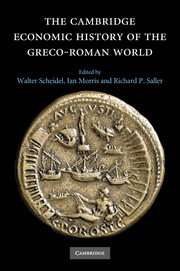Book contents
- Frontmatter
- 1 Introduction
- Part I Determinants of Economic Performance
- Part II Early Mediterranean Economies and the Near East
- Part III Classical Greece
- Part IV The Hellenistic States
- 15 The Hellenistic Near East
- 16 Hellenistic Egypt
- 17 Hellenistic Greece and Western Asia Minor
- Part V Early Italy and the Roman Republic
- Part VI The Early Roman Empire
- Part VII Regional Development in the Roman Empire
- Part VIII Epilogue
- Bibliography
- Index
- Map 1.1 The Mediterranean basin"
- Map 10.1 Greek and Phoenician trade in the period of the Persian Wars"
- Map 11.1 The Achaemenid empire"
- Map 12.1 Greece and Asia Minor"
- Map 15.1 The Seleucid empire"
- Map 16.1 Greco-Roman Egypt"
- Map 20.1 The Roman empire at the accession of Vespasian"
- References
16 - Hellenistic Egypt
from Part IV - The Hellenistic States
Published online by Cambridge University Press: 28 March 2008
- Frontmatter
- 1 Introduction
- Part I Determinants of Economic Performance
- Part II Early Mediterranean Economies and the Near East
- Part III Classical Greece
- Part IV The Hellenistic States
- 15 The Hellenistic Near East
- 16 Hellenistic Egypt
- 17 Hellenistic Greece and Western Asia Minor
- Part V Early Italy and the Roman Republic
- Part VI The Early Roman Empire
- Part VII Regional Development in the Roman Empire
- Part VIII Epilogue
- Bibliography
- Index
- Map 1.1 The Mediterranean basin"
- Map 10.1 Greek and Phoenician trade in the period of the Persian Wars"
- Map 11.1 The Achaemenid empire"
- Map 12.1 Greece and Asia Minor"
- Map 15.1 The Seleucid empire"
- Map 16.1 Greco-Roman Egypt"
- Map 20.1 The Roman empire at the accession of Vespasian"
- References
Summary
introduction
I treat here the internal economic history of the Ptolemaic dynasty, the longest lived of the Hellenistic successor states, leaving aside the Ptolemaic empire (relevant to the first half of the period, or roughly from 330–168 bc), the role of military conquest (its expenditure and revenue), and international trade. The following can in no way stand for a synthesis. Much important work is underway, or about to appear, on various aspects of the Ptolemaic economy, and there is still considerable unpublished material, particularly written in Demotic Egyptian, which bears on the understanding of the economy. The period was remarkable in the economic history of the Mediterranean, when Greek immigrants’ institutions were integrated with ancient modes of production and social organization. Like the Seleucid dynasty, the Ptolemies established themselves on a Persian foundation and provided a new incentive structure for state service and private economic activity. Egypt had been an important trade axis connecting the Mediterranean to the east and south for a millennium before the Ptolemies, but Greek immigration, the new city of Alexandria, and Greek institutions had profound effects.
Despite the relative abundance of documentation, much remains unclear or uncertain with respect to revenue and expenditure, and thus, there are severe limits to the quantification of performance. Some subjective measures are possible. The building of new urban centers at Alexandria and Ptolemais, the founding of new villages (especially in the Fayyum), and the construction of new temples is one obvious measure of expansion. The most serious absence of evidence is our restricted knowledge of the Greek urban centers (Alexandria, Naucratis, Ptolemais).
Keywords
- Type
- Chapter
- Information
- The Cambridge Economic History of the Greco-Roman World , pp. 434 - 459Publisher: Cambridge University PressPrint publication year: 2007
References
- 42
- Cited by



